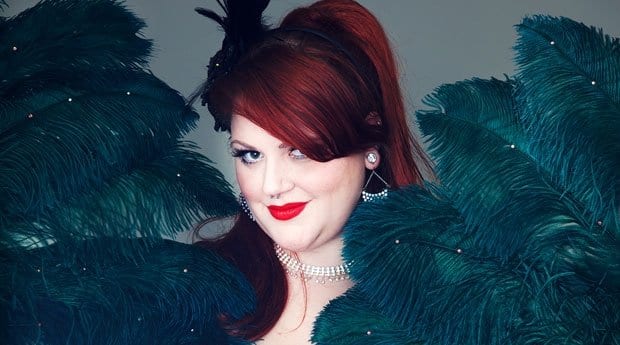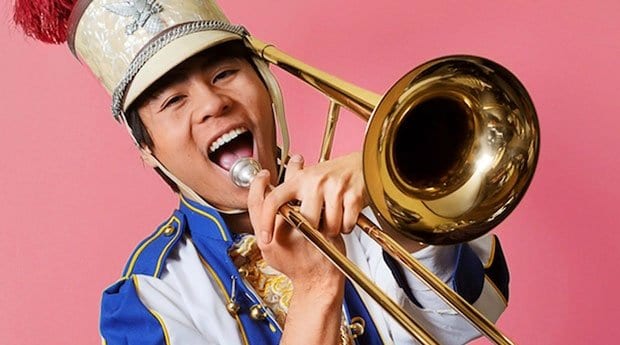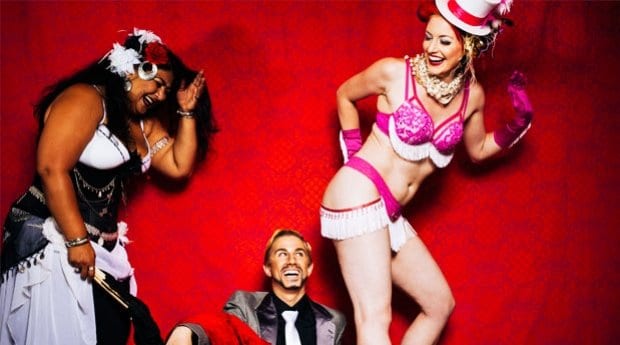
Helvetica Bold brings smarts and sexiness to her titillating performances. Credit: XXXXX

Wrong Note Rusty brings smarts and sexiness to his titillating performances. Credit: XXXXX
As the summer ends and the days turn cool, the festival season in Ottawa starts to wind down. But before you pack up your short-shorts and break out the fall woolies, there’s one last festival to check out — one that promises to keep things hot.
Held from Sept 19 to 21, the first annual Ottawa Burlesque Festival is bringing performers from around the world to the city for a three-day extravaganza of sequins, feathers and performances that will turn you on, make you laugh and make you think.
“Burlesque festivals are something that exist within the global burlesque community all over,” organizer Miss Helvetica Bold says. “I guess it’s comparable to the leather community, where you have these competitions and celebrations and workshops all over the world in these big cities. So with burlesque it’s the same thing.” In 2012, she and a group of organizers decided it was time Ottawa got its own festival; over the last two years they’ve worked to create one.
Burlesque as a medium can be sexy, and much of it is. But it can also be funny, subversive and even poignant. And while sexy ladies in pasties are a big part of burlesque, they’re far from being its only stars. Drag kings and boylesquers have been carving out a niche for themselves in recent years, bringing a healthy dose of genderbending to the art form.
On the drag-king front, Master Cameron Eric Leon will bring some masculine energy to the festival. Recently crowned Mr Capital Pride, Leon has had a meteoric rise in Ottawa since he first started performing in weekly drag shows at Swizzles less than a year ago. As someone who identifies as genderqueer, he says that drag gives him an outlet to explore outside the binary. “It really is all about gender and challenging gender norms, which is one of the things I like best about it.”
Leon’s performing style combines a dapper masculine aesthetic — think Cary Grant — with an over-the-top goofy physicality and a certain amount of tongue-in-cheek humour. He sometimes combines elements of both masculine and feminine drag for what he describes as gender-fuck numbers. This style of performance is a perfect fit for burlesque. “There isn’t just a binary, and I know some burlesque performers will even call the makeup that they do … their drag, because it is basically an accentuation of gender,” he says.
When we talk about burlesque it’s impossible not to mention striptease, which is so often associated with the male gaze. A conventionally attractive woman slowly disrobing to show off her best assets might seem incredibly heteronormative at face value, but tropes like these exist to be subverted — and when it comes to burlesque, that’s half the fun.
“If there was a Venn diagram of strip-club stripping and burlesque, there would definitely be a big overlap, but burlesque is not exclusively striptease,” Bold says. “Any performance that is focused on or around gender or bodies or sexuality in any way tends to work well, whether it’s physical comedy or gender illusion or stripping.”
Leon, for instance, often performs strip numbers where he peels off layers of menswear. “I think [drag] fits in really, really well because it’s not only a form of performing art but it’s also a form of challenging part of the mainstream ideals,” he says. “Whereas burlesque does that with … body [types] and stuff like that, drag will also challenge those similar notions when it comes to gender.”
Another growing contingent in the burlesque community is boylesque, which involves male performers who subvert the medium’s traditional sexy-lady image. “As [male performers] in the burlesque scene, we kind of have it easy right now,” says Wrong Note Rusty, who performs with Toronto troupe BoylesqueTO and spoke with Xtra via email.
“Boylesque is on the rise, but it’s still relatively novel and very much in demand, and so I think one of the big challenges is finding ways to do burlesque that are fresh and fun that don’t merely rely on the novelty of just looking different,” he says. “I would say that probably half of what we do in BoylesqueTO comes with a large side of gay subtext, if not outright homosexual propaganda.”
Rusty’s particular brand of boylesque typically involves comedy; he often performs as the underdog, whether it’s the high-school band geek or the jilted lover. While he doesn’t focus as heavily on gender play in his acts, he says he feels it’s implicit in the art form. “A lot of boylesque borrows vocabulary and form from the performance of femininity, so often a sense of gender play is implicated in the way a man just takes his sock off, because of what a staple the ‘stocking peel’ move is in burlesque at large.”
As a cisgender man who identifies as both queer and gay, Rusty says another challenge in boylesque is participating in the scene from a feminist perspective. “Burlesque, like any art form, can reinforce some modes of oppression in as much as it can subvert them. To occupy a space of privilege as a performer of boylesque, in a scene and art form that centres so particularly around women and femininity, presents a challenge that is fascinating and rewarding and occasionally problematic,” he says.
Some of the challenges faced by burlesque as a medium are based in the fact that it’s a woman-dominated community. “I think it’s unfortunate that burlesque is still kind of underground,” Bold says. “It hasn’t quite reached ubiquity — I think it’s getting there, but I think because it is a female-dominated art form, we’re never going to reach mainstream status. It’s just a section of the populace that’s always oppressed at least a little bit.”
Burlesque, she says, is a medium where queer sexuality is accepted and embraced and where, to a large extent, all bodies are treated as good bodies. “I’m a queer-identified cisgendered woman, and in the burlesque community, I don’t feel like my sexuality has ever been taboo or a question or even anything anyone cared about,” she says. “It’s just a very accepting environment for everyone, no matter what body they have, what gender they identify as, or who they like to have sex with.”
Ottawa Burlesque Festival
Fri, Sept 19–Sun, Sept 22
ottawaburlesquefest.com


 Why you can trust Xtra
Why you can trust Xtra


